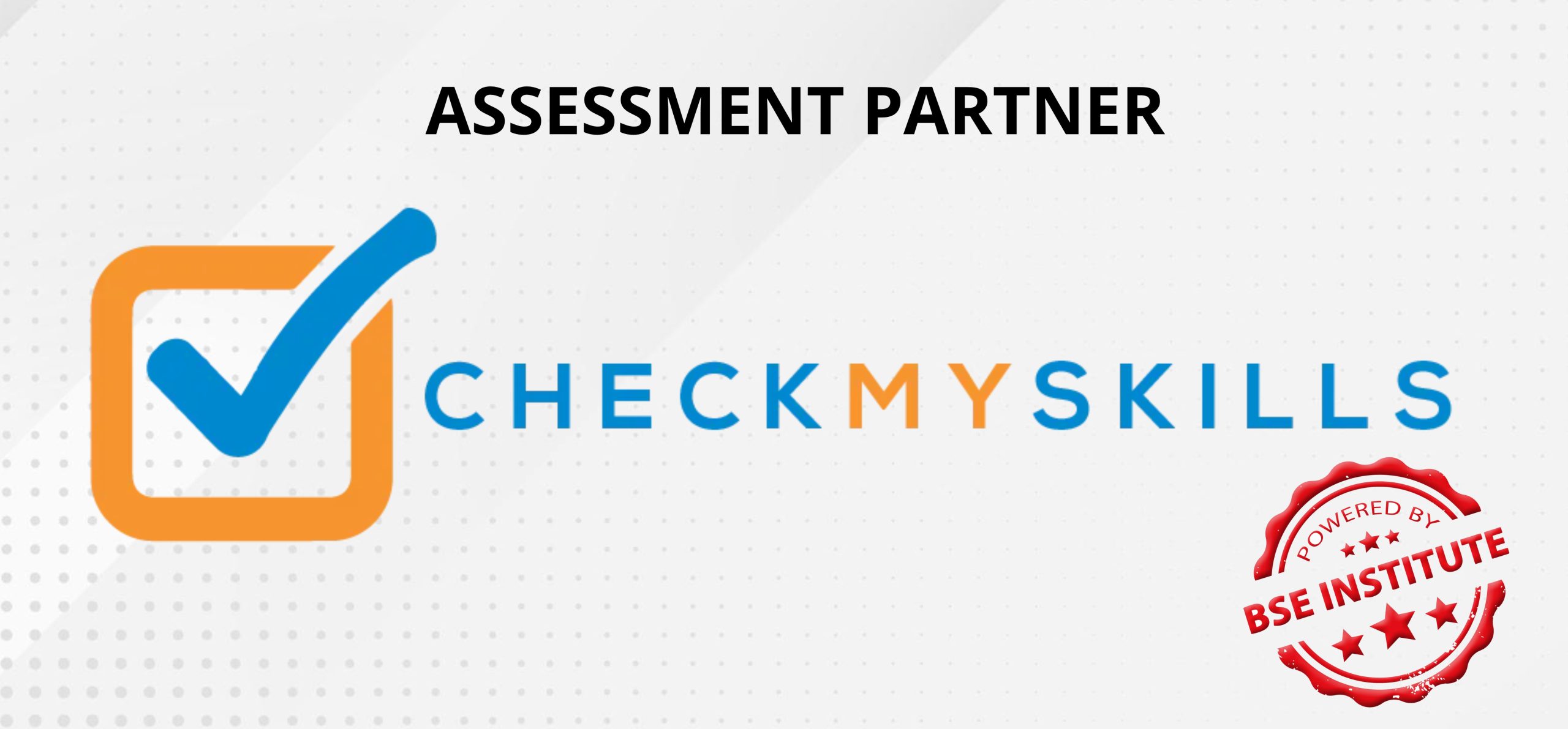According to the Chicago Board Options Exchange (CBOE), 73% of professional options traders use covered calls as their income strategy. No wonder, it is one of the most consistent ways to make money from your stock portfolio while managing risk. This Covered Call Strategy allows you to sell the right to buy your shares at a certain price, so you can see the benefits and risks.
In this guide we will show you how to use covered call strategy to potentially create monthly income from your existing stock positions. Whether you are a conservative investor looking to boost your returns or an active trader looking for income strategies, you need to understand the covered calls for your options trading journey.
Understanding the Fundamentals of Covered Calls
A covered call strategy involves two things: owning 100 shares of stock and selling (writing) one call option against those shares. This creates a position that generates immediate income from the option premium and potential upside in the stock up to the strike price.
The mechanics are simple: when you sell a call option you get paid a premium upfront. This premium is your maximum profit from the options part of the strategy. In exchange, you agree to sell your shares at the strike price if the stock goes above that level.
Let’s take a real-life example in the Indian context:
You own 100 shares of XYZ stock at ₹1,000 per share. You decide to sell one call option with a ₹1,050 strike price expiring in 30 days for ₹15 per share (₹1,500 total premium).
In this case:
- Maximum profit = Premium received + Stock appreciation to strike price
= ₹1,500 + (₹1,050 – ₹1,000) × 100 = ₹1,500 + ₹5,000 = ₹6,500 - Maximum loss = Stock going to zero – Premium received
= (₹1,000 × 100) – ₹1,500 = ₹98,500 - Break-even = Stock purchase price – Premium received per share
= ₹1,000 – ₹15 = ₹985
What is a Covered Call?
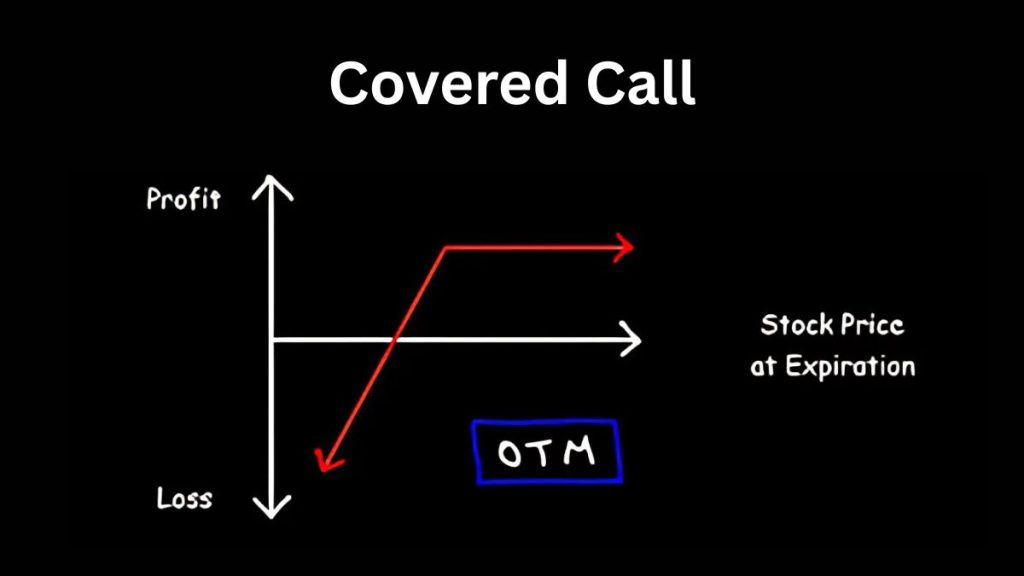
Definition and Purpose of Covered Call
A covered call is an options trading strategy used by experienced investors to reduce risk and limit losses. The purpose of this is to sell covered calls generate extra income from an existing stock position by selling call options on the same stock.
This strategy is good in a flat or mildly bullish market where the stock price is not expected to move much.
Components: Stock Price, Strike Price, and Expiration Date
A covered call involves three components: stock price, strike price, and expiration date. The stock price is the current market price of the underlying stock. The strike price is the price at which the buyer of the call option can buy the underlying stock. The expiration date is the last day the call option can be exercised.
Selling a Call on an Existing Stock
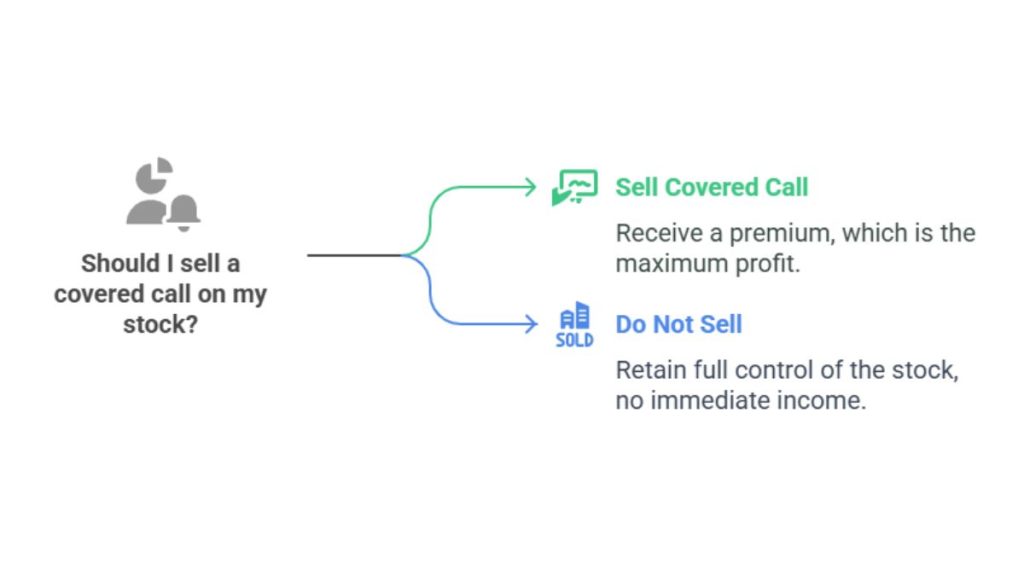
To sell a covered call you must own the underlying stock. You sell a call option on the same stock, giving the buyer the right to buy the stock at the strike price on or before the expiration date. In exchange for selling the call option, you get a premium, which is the income from the strategy. The premium is your maximum profit from the strategy and is yours regardless of the outcome.
If the stock goes above the strike price the call will be exercised and you will have to sell the stock at the strike price. If the stock goes down or doesn’t move the call will expire worthless and you will keep the premium as profit.
A covered call provides downside protection only to the extent of the premium received and limits your upside to the strike price plus the premium received.
In volatile markets, the premiums on call options tend to be higher — which might seem attractive — but this can also increase the risk of your call being exercised early.
By selling a call on shares you already own, you can generate additional income and reduce your risk. But you must carefully consider the stock price, strike price and expiration date to get the most out of the covered call strategy.
Choosing the Right Stocks for Covered Calls
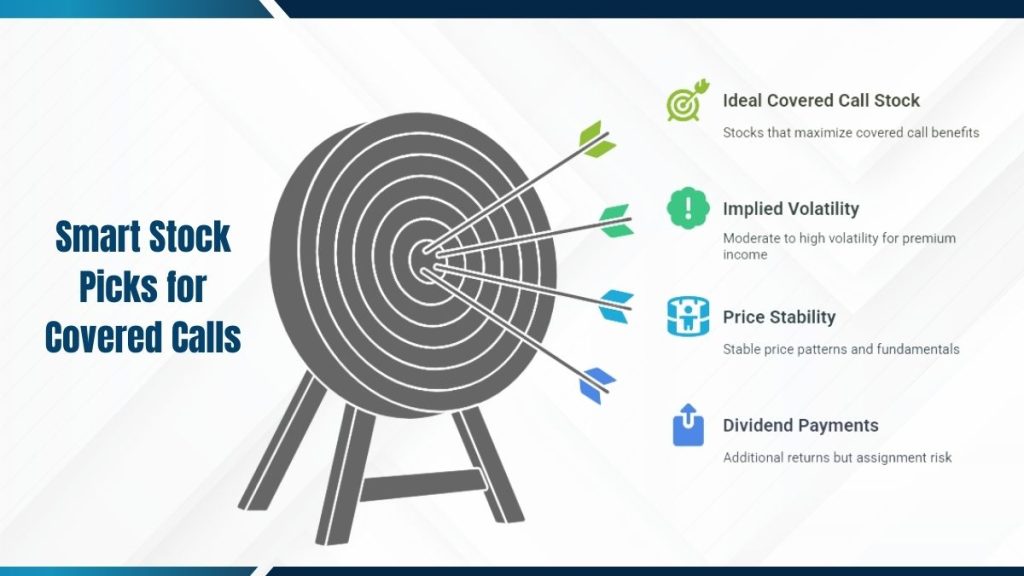
The success of a covered call depends on choosing the right underlying stocks. The ideal candidates will have:
First, moderate to high implied volatility, typically between 20% to 40% annually. Higher implied volatility means higher option premiums and more income for you. However extremely high volatility means more risk.
Second, look for stocks with stable price patterns and strong fundamentals. Blue chip stocks are great covered call candidates because they tend to trade in a range and never make big moves.
Stock selection should also consider dividend payments. Dividends can add to your overall return but can increase the risk of early assignment especially when your calls are in the money near ex-dividend dates.
Stock price declines can affect the success of a covered call but the premiums you get from selling options can offset the losses and provide downside protection to you.
Strike Price and Expiration Strategy
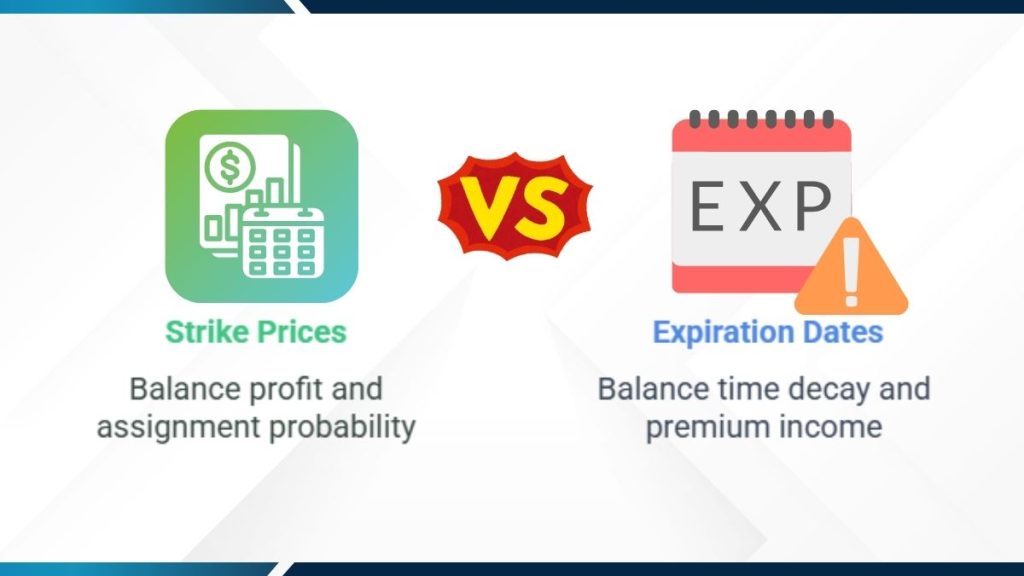
The strike prices and expiration dates are the heart of your covered call strategy. This is where you balance profit and downside protection.
When choosing strike prices consider the stock price and the option’s delta. A delta of 0.30 to 0.40 usually provides the best balance between premium income and probability of assignment. This is usually 5-10% out of the money.
For expiration dates, you’ll want to balance time decay (theta) with premium income. Shorter-term options (30–45 days) benefit from faster time decay, while longer-term options (60–90 days) offer higher absolute premiums—ideal if the stock price remains relatively stable over time.
Risk Management and Position Monitoring
Covered call writing requires discipline. Limit your position size to no more than 5% of your portfolio for anyone covered call. This diversification will protect you from company-specific risk. Owning the underlying stock in a covered call is key as it will limit your loss if the stock goes up big.
Monitor your positions regularly and watch:
- Stock price vs strike price
- Implied volatility changes
- Ex-dividend dates
- Technical support and resistance
When the stock price moves big, roll your options. Rolling means buying back your current option and selling another with a different strike price, expiration date, or both.
Advanced Covered Calls
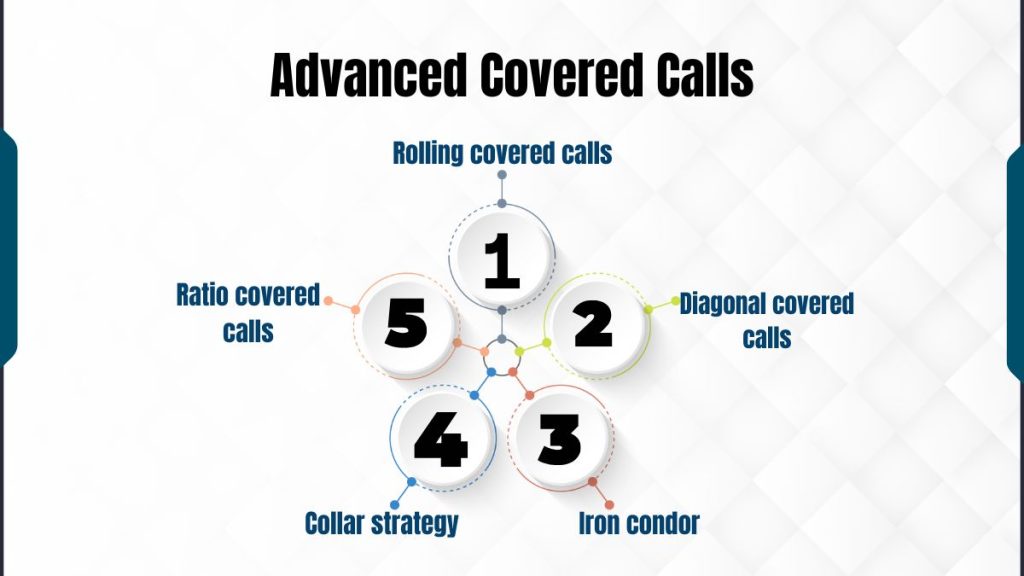
As you get more experience you can try advanced variations of the basic covered call: Selling covered calls can be a monthly or quarterly habit and can bring you extra income and tax benefits.
The Poor Man’s Covered Call uses LEAPS options instead of stock ownership to reduce capital requirements. This variation increases leverage and potential return but also adds risk and complexity.
A collar strategy is a combination of covered calls and protective puts that creates a defined risk range. You give up some upside for downside protection.
During earnings season consider adjusting your strategy to account for the volatility. This might mean using wider strikes or waiting until after the announcement to sell calls.
Conclusion
Covered calls is a powerful way to generate income and manage risk. Success requires good stock selection, strike and expiration choices, and position management.
Remember like any investment strategy covered calls requires continuous learning and adaptation to the market. Start conservative, master the basics and then add more advanced techniques as you gain experience.
Ready to improve your options trading skills? Check out our options trading courses at IFMC where you’ll learn advanced covered call strategy and more. Our experienced instructors will walk you through real life examples and help you develop the skills to trade options successfully.
Get started with covered calls today – your portfolio will thank you tomorrow.
A covered call is a conservative options trading strategy that combines stock ownership with call option selling to generate income. By owning 100 shares an underlying asset (typically a stock) and selling one call option against those shares you can get immediate income and keep the upside in the stock up to the strike price. This works best with stable, blue chip stocks that have moderate volatility (20-40% annually) and selling slightly out of the money calls with 30-45 days to expiration. The maximum profit is limited to the premium received plus any stock appreciation up to the strike price but covered calls can add to your portfolio returns through regular income and some downside protection through the premium received. 73% of professional traders use this as their primary income strategy so it’s a great option for investors who want to balance income with risk management.
Covered Call FAQs
What is a covered call and how does it work?
A covered call is a strategy to generate income by owning 100 shares of stock and selling (writing) a one-call option against those shares. When you sell the call option you get a premium payment immediately. This premium is income you keep no matter what happens to the stock price. In exchange, you agree to sell your shares at the strike price if the stock goes above that level before expiration. Think of it like being a landlord who collects rent (the premium) while giving your tenant (the option buyer) the right to buy your property (the stock) at a predetermined price.
What are the max profit and loss for covered calls?
The max profit from a covered call is the premium received from selling the call option plus any stock appreciation up to the strike price. For example, if you own stock at ₹1,000 and sell a ₹1,050 call for ₹15, your max profit would be ₹6,500 (₹1,500 premium + ₹5,000 stock appreciation). The max loss is if the stock goes to zero and is your initial stock investment minus the premium received. In this case, that would be ₹98,500 (₹1,00,000 – ₹1,500).
How do I choose the right stocks for covered calls?
The best stocks for covered calls have a few characteristics. Look for stable, blue chip companies with moderate volatility (20-40% annually). These stocks should have a history of price patterns and strong fundamentals. Make sure the stock has liquid options with tight bid-ask spreads. Consider stocks you wouldn’t mind holding long-term as you may end up holding the shares if the price falls. Companies with stable dividend policies can also be good candidates but be aware of ex-dividend dates.
What is the ideal time frame for covered calls?
Most covered call traders focus on options with 30-45 days to expiration. This time frame provides the best balance between premium income and time decay (theta). Shorter-term options (less than 30 days) may have faster time decay but require more trading and higher commissions. Longer-term options (beyond 45 days) have higher absolute premiums but tie up your capital for longer and have slower time decay.
How do dividends affect covered calls?
Dividends are important in covered call strategies. They can add to your overall returns but also increase the risk of early assignment especially when your calls are in-the-money near ex-dividend dates. If the dividend is greater than the remaining time value in the option there is a higher probability of early assignment as option holders will exercise to capture the dividend. So be aware of ex-dividend dates and adjust your strategy accordingly.
What happens if the stock goes above the strike?
If the stock goes above the strike your shares may be “called away” (assigned) at expiration or before if early exercise occurs. This means you’ll sell your shares at the strike price regardless of how high the stock goes. While this limits your upside you still keep the premium received from selling the call. Some traders choose to “roll” their position by buying back the current option and selling a new one with a higher strike or later expiration.
How do I manage risk in covered calls?
Risk management for covered calls involves a few key practices. First, diversify your positions so no single covered call is more than 5% of your portfolio. Monitor your positions regularly, and watch for changes in stock price, implied volatility, and upcoming events like earnings. Consider using technical analysis to find support and resistance levels for better strike price selection. You may also use stop loss on the stock position or options Greeks (especially delta and theta) to guide your decisions. In volatile markets, you may want to add protective puts to create a collar.
Can I do covered calls in an IRA?
Yes, covered calls are generally allowed in IRA accounts as they are considered a conservative options strategy. In fact, they are one of the few options strategies allowed in retirement accounts. But check with your broker as policies can vary. In an IRA you can’t use margin so you must have enough cash to buy 100 shares of stock for each covered call position you want to establish.





















